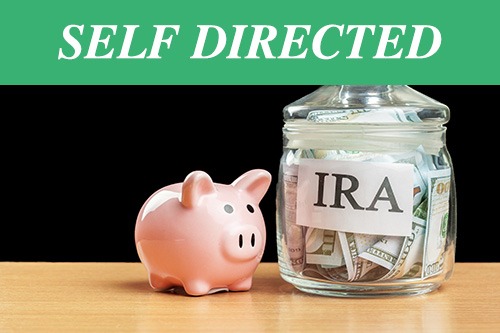702-660-7000
702-660-7000

Many people are familiar with regular individual retirement accounts (IRAs) which hold stocks, bonds, certificates of deposit, and mutual or exchange-traded funds. However, few people understand the characteristics of another major retirement account—self-directed IRAs (SDIRA). We are going to cover what self-directed IRAs are, what their benefits and risks are, and who should use them.
A self-directed IRA is a type of individual retirement account that allows for investing in alternative assets outside of the normal stocks and bonds. Self-directed IRAs are completely managed by the account holder through a third-party custodian. This means the account holder must have extensive knowledge about specific investments as well as the ability to assess the risk and opportunity of an investment. They may choose to seek advice from a financial advisor or rely upon their own expertise. However, before an individual can invest, he or she must decide which type of self-directed IRA makes the most sense for their financial goals. The two main types of self-directed IRAs are Traditional and Roth.
The major difference between these two types of self-directed IRAs are when you pay taxes. For a traditional self-directed IRA, you only pay taxes on your contribution and earnings as you withdraw them. For a Roth self-directed IRA, you don’t receive an upfront tax break, but your earnings and contributions will grow tax-free, and distributions are also tax-free.
Depending on your interests and the current market, you may decide to invest into a number of diverse assets. You may choose to invest within one industry or diversify your account with varied assets. Some of the popular assets for self-directed IRAs include:
You can’t invest in anything you want to with a self-directed IRA. The IRS has strict guidelines as to what assets may and may not be acquired. Some of the prohibited investment assets include:
Top benefits for choosing a self-directed IRA account are more control over your investments, potential for higher-returns, and possibly protection against economic fluctuations, depending on the way you invest.
More Control Over Your Investments
As the account manager, you become the expert on your investments. As you stay up with market trends, you can use your knowledge of a particular industry as competitive leverage in making smart financial decisions.
Potential for Higher-returns
Self-directed IRAs can give you more flexibility on your investments and potentially a higher rate of return on those investments. Basically, SDIRAs give you more options when it comes to choosing your investment portfolio, which can increase your opportunity for higher returns. Making these investments through the IRA has the potential to defer or eliminate taxes on your earnings.
Protection Against Economic Fluctuations
Diversifying your investments can help in protecting against economic recessions. Some assets and investments, such as gold, tend to hold their value over long periods of time. Investing in commodities can be a valuable protection for your financial future.
Self-directed IRAs come with some BIG risks beyond what you would typically consider investment risk. Some of these risks include prohibited transactions, tax compliance, due diligence, fees, and lack of liquidity.
Prohibited Transactions
A prohibited transaction refers to breaking any of the rules of a self-directed IRA. These rules can be extensive, so you should familiarize yourself with all the guidelines before investing.
For example, you should never borrow money from your own IRA. Management and upkeep of all SDIRAs should be taken care of through the third-party custodian. If your SDIRA will own rental property, you should not try to fix a broken air conditioner by yourself. Instead, you would hire someone with funds from your self-directed IRA. You should always keep your business and personal finances separate from your SDIRA investments.
Failure to understand these rules can result in big penalties – up to 100% of the prohibited transaction if you don’t reverse it within the same tax year. Or the IRS could disqualify your SDIRA and you would have to pay income tax on the entire balance in one year. Check out the IRS’s complete list of prohibited rules.
Tax Compliance Risk
When it comes to self-directed IRAs, tax compliance is a HUGE issue. It is estimated that “less than 50% of SDIRA investors handle the legal and tax issues correctly”!
Most of these investors don’t even know they have a problem.
Even if you think you’re complying with all the rules there are caveats that your IRA custodian is not expected to monitor for you.
For example, you’ll need to know when certain investments could trigger unrelated business taxable income (UBTI) or unrelated debt-financed income (UDFI). If they do, your IRA might need to file a tax return and it would pay taxes at trust tax rates, which are much higher than individual tax rates.
A mistake in this area might be as simple as investing in real estate that is partially financed by a bank. Even if you are not directly involved in managing the real estate, the income could be partly taxable because the investment is partially “debt-financed”.
Due Diligence
As mentioned, you should have an in-depth understanding of the industry or niche where you choose to invest. Lack of adequate knowledge can lead to higher risk and greater losses in the long-run. You should also take into consideration the time and effort needed to manage a SDIRA before choosing this option.
Fees
Fee structures vary with different self-directed IRA custodians. These fees can easily add up so ask and be aware of additional fees your IRA investment could incur.
Lack of Liquidity
Assets in an SDIRA are often illiquid meaning they cannot easily be turned into cash. For an individual looking to use funds from an SDIRA, he or she will need to find an interested buyer before turning their asset into cash. This can be a disadvantage for those looking to use this investment as an “extra savings” account.
Self-directed IRAs are not for everyone. Understanding the annual contributions and your level of commitment for the investment selection and tax compliance can help in determining if this is the right step for you.
Annual Contributions
As of 2020, annual contributions to a self-directed IRA account cannot exceed $6,000 per year or $7,000 per year if you are older than 50. For people looking to invest in real estate or other expensive assets, they may be unable to reach the amount needed to purchase a property for several years. One solution is to transfer investments of a regular IRA into a self-directed IRA, but this is not always the best solution overall.
Level of Commitment
Individuals interested in self-directed IRAs should consider their personal level of commitment to researching and managing an investment. Choosing a self-directed IRA means significant research, number crunching, and financial knowledge. Not everyone will have the time or interest in managing their own account. However, if you are an expert in a certain investment niche, creating a self-directed IRA to make those investments may give you a competitive advantage.
If you want more flexibility with your investments without the tax compliance limitations and management hassles, certain whole life insurance products designed for high-cash value can be good tools to build “extra savings”.
You can leverage cash values as needed to make investments that don’t play well with self-directed IRAs and you don’t lose growth during the down-time between investments.
Growth inside a whole life insurance policy is still tax-deferred although premiums are not. Investments you make outside of a self-directed IRA will probably be taxable, but that doesn’t mean they are not good investments.
Using life insurance as a savings tool can be a good strategy when you don’t want to lock away too much money in tax-deferred retirement plans that could limit your future investment opportunities. Planning with whole life insurance can also expand your options for passive income in retirement.
SDIRAs may be a good option for someone who is willing to do their due diligence and meticulously follow all of the rules, but whole life insurance is a better option for people who don’t want to spend lots of time with SDIRA compliance issues. Whole life insurance is also a good option for SDIRA owners because rules and regulations can keep SDIRA owners from accumulating as much as they wish.
With a well designed whole life policy you can get many of the benefits with none of the headaches. At McFie Insurancewe specialize in designing whole life insurance to meet the proper criteria for people who want to grow their wealth. If you want to grow your wealth with a whole life policy, schedule an appointment.
 Tomas P. McFie DC PhD
Tomas P. McFie DC PhD
Tom McFie is the founder of McFie Insurance and co-host of the WealthTalks podcast which helps people keep more of the money they make, so they can have financial peace of mind. He has reviewed 1000s of whole life insurance policies and has practiced the Infinite Banking Concept for nearly 20 years, making him one of the foremost experts on achieving financial peace of mind. His latest book, A Biblical Guide to Personal Finance, can be purchased here.